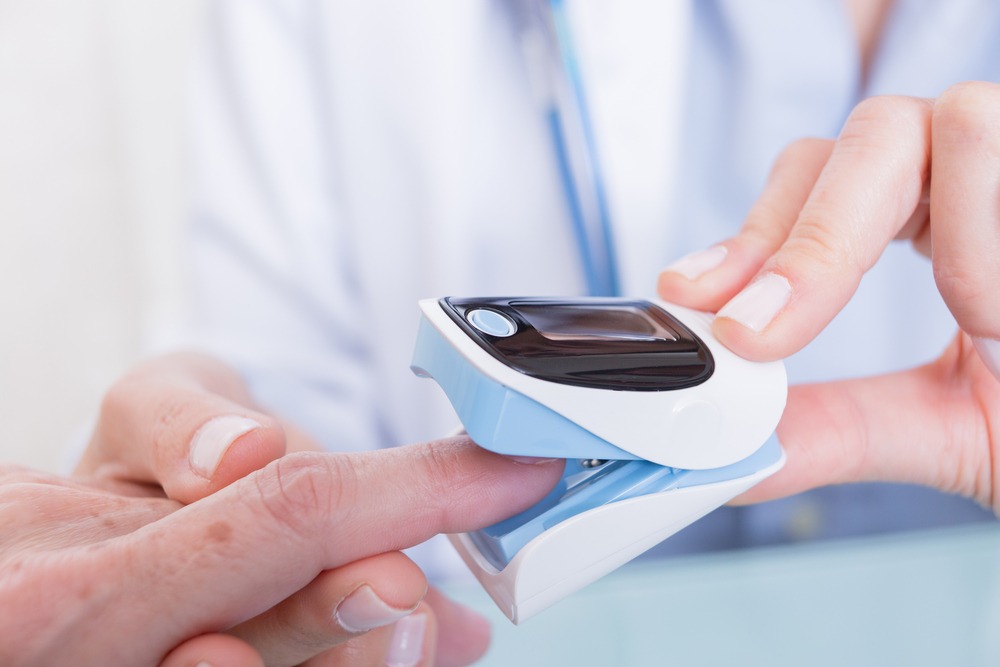Pulse oximeter devices are being rolled out across England by the NHS in an effort to monitor those most at risk of mortality and treat them faster

Blood-oxygen levels detected by pulse oximeters are being used to detect signs of deterioration while Covid-19 patients are at home (Credit: Shutterstock/Click and Photo)
The Covid-19 pandemic has driven innovation all over the medical devices sector, but one of the latest tools in the arsenal of healthcare professionals is none other than the humble pulse oximeter – a common device for measuring blood-oxygen levels.
The first oximeter was invented in the 1940s and took the reading from the earlobe, but required calibration on a bloodless ear and for the lobe to be heated to 44°C
In 1972, the pulse oximeter was invented, improving on previous oximetry technology by removing the necessity of calibrating and then using it on an earlobe, now commonly being clamped on to the finger or toe of patients.
From here, the technology only continued to evolve and is now a staple of modern medicine.
The need to monitor blood-oxygen levels with a pulse oximeter can arise across a range of diseases, especially those of a respiratory nature, due to its ability to signal whether breathing is impaired and indicate that a patient may require ventilation.
It’s for this reason that NHS England in the UK has promoted the use of the device through schemes designed to remotely monitor those with Covid-19 at high-risk of complications from the disease.
Here, we take a look at how a pulse oximeter uses light to determine the percentage of oxygenated blood in a person’s body, and how its use can give doctors the upper hand when patients deteriorate due to Covid-19.
How does a pulse oximeter work?
The delivery of oxygen to a tissue depends on sufficient oxygen content in arterial blood, as well as uninhibited blood flow to the tissue.
Oximetry is a technique for measuring whether oxygen content is sufficient by recording the amount of light transmission through the blood.
The reason light works as a measurement tool is that oxygenated and deoxygenated haemoglobin absorb different types of light in different quantities.
Oxygenated haemoglobin absorbs more infrared light and allows more red light to pass through, while deoxygenated haemoglobin allows more infrared light to pass through and absorbs more red light.
The pulse oximeter uses the the ratio of oxygenated to deoxygenated haemoglobin to calculate how much oxygen the blood is carrying as a fraction of the maximum it could carry, expressing the result as a percentage of oxygenation, or SpO2 to medical professionals.
In a healthy individual, SpO2 should be between 96% to 99%, but Covid-19 has been known to drive the number below 85% in the most serious cases, which tend to result in patients being intubated and placed on mechanical ventilation to assist breathing.
How are pulse oximeters being used during the pandemic?
In early September, NHS England began pilot testing the use of pulse oximeters to create what it called “virtual wards” in Tees Valley, Slough and North West London.
Each of these schemes had a different set up, but the basic principle of patients taking readings and relaying them to local health teams was applied.
As of right now (26 November), the results of the pilot study have not been published, but results from a previous study, led by Matthew Inada-Kim, NHS England national clinical lead for deterioration as well as a consultant in acute and general medicine at Hampshire Hospitals NHS Foundation Trust, have been used to support further rollout of oximetry schemes.
The study has yet to undergo peer review, so its results should be approached with caution, but after identifying 1,080 adults with a Covid-19 diagnosis who were taken by ambulance to one of three hospitals between March 1 and July 31, vital signs measured by staff at first point of contact correlated with short-term mortality or ICU admission, with SpO2 the most predictive measure.
In terms of numbers, the study found that at an SpO2 of 94% or 93%, mortality risk increased to around 13%, and if it fell below that level the risk would increase to about 28%.
A key concern driving the NHS to push for more monitoring through pulse oximeter schemes is the phenomenon of “silent hypoxia” – where desaturation occurs but patients exhibit no obvious symptoms – since it was recorded in enough people to become associated with Covid-19 as a potential feature.
In a recent announcement, NHS England indicated that pilot results had been successful enough to warrant rolling out pulse oximeters – of which it is believed to have 200,000 – to the whole of England through schemes set up to monitor the most vulnerable.
